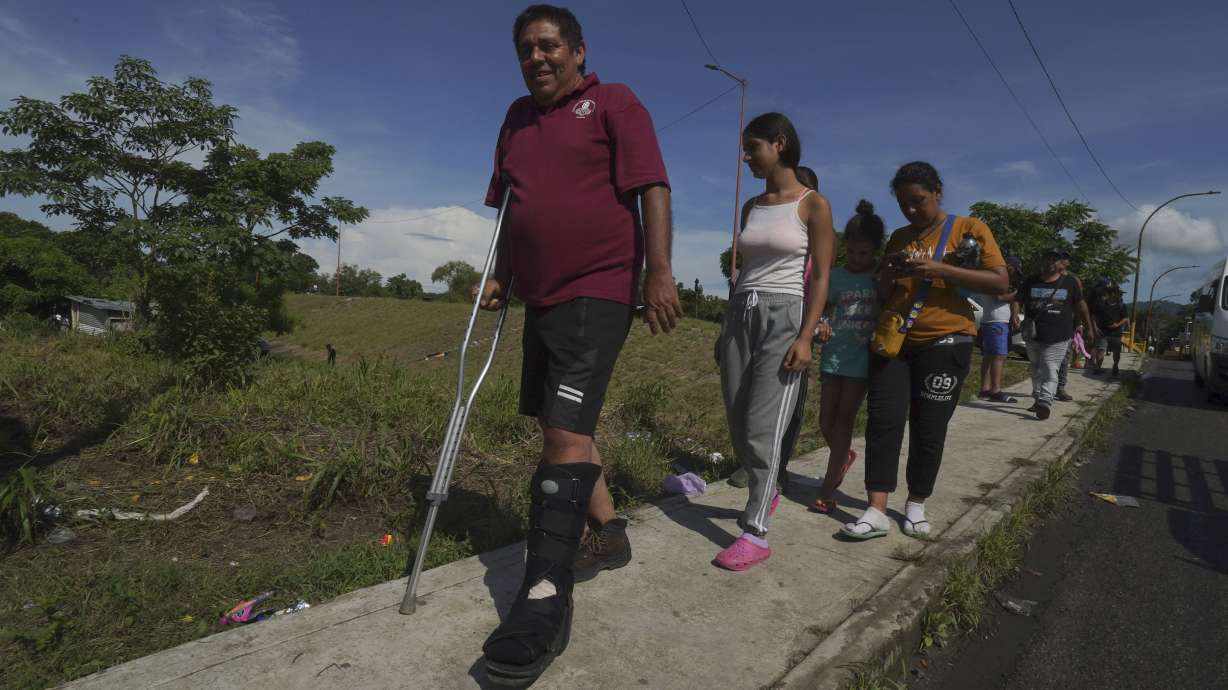Estimated read time: 4-5 minutes
This archived news story is available only for your personal, non-commercial use. Information in the story may be outdated or superseded by additional information. Reading or replaying the story in its archived form does not constitute a republication of the story.
SALT LAKE CITY — The largest migrant caravan of the year set off toward the U.S.-Mexico border last week, coinciding with a regional summit where President Joe Biden announced changes to American immigration policy.
By Saturday, Mexican authorities announced they had issued 7,000 temporary documents and travel visas, and reported that the caravan had largely dispersed — however, the majority are still attempting to cross the border into the U.S., according to The Associated Press.
What's driving the news: Migrant caravans are a common way for people fleeing violence in South and Central America to travel north. Though the caravans themselves are usually broken up before they reach points of entry, many of the migrants eventually apply for asylum at the U.S. border.
Despite claims that the caravan was dispersed, reports indicate that thousands of migrants will be traveling north in the coming weeks. Here's what we know:
- Over 6,000 migrants had stopped in Tapachula, Mexico, many of them waiting for the temporary documents needed to travel north to the U.S. border.
- The caravan was initially estimated to grow to as many as 15,000 people. That would have made it the largest to ever assemble in Mexico, though it's now fizzling out as many asylum-seekers make individual travel plans after being granted the necessary documents from Mexican authorities.
- The asylum-seekers headed for the border will add to what is likely hundreds of thousands of people stuck in limbo after being turned away due to Title 42, a Trump-era public health policy.
- Many are from Venezuela and have already made the treacherous journey through the Darién Gap, a remote stretch of jungle in Panama and Columbia where kidnapping, sexual violence and theft are common. Over 32,000 migrants, 16,000 of them Venezuelan, have walked the lawless stretch this year.
- The U.S. Border Patrol has reported more than 1 million encounters with migrants along the southwest border in 2022, on pace to exceed last year's record high of 1.7 million. The agency estimates an additional 60,000 cross the border undetected each month.
Changes to U.S. immigration policy: Biden and leaders from several mostly South American countries met this week in Los Angeles to discuss the northern flow of migrants that is reaching record numbers.
The leaders of Cuba, Nicaragua and Venezuela were not invited, a high-profile source of controversy that led to Mexican President Andrés Manuel López Obrador refusing to attend.
Here are some key takeaways from the summit:
- The U.S. will admit 20,000 refugees from Latin American countries over the next two years, three times as many as the current limit.
- An additional 11,500 seasonal worker visas will be issued to migrants from Central America and Haiti.
- The Biden administration will allocate $314 million to support Venezuelan migrants — $171 million of that will go toward food and humanitarian relief for immigrants and refugees currently in South America.
- Mexico will accept a minimum of 20,000 additional temporary workers, and unveiled a new program to accept up to 20,000 Guatemalan workers.
- Canada will accept 4,000 refugees from the Americas.
The latest on Title 42: The public health law that the Biden administration said would expire in May, before a judge prevented it from doing so, has reduced asylum-seekers crossing the border to a trickle.
Originally instated by the Trump administration in the early months of the pandemic, Title 42 allows the Border Patrol to turn away people and property "in the interest of public health."
Although the law was upheld, for now, it's unclear how the administration will handle the current backlog of asylum-seekers along the U.S.-Mexico border, bolstered in the coming weeks by the latest wave of migrants. The Department of Homeland Security recently announced it is preparing for roughly 18,000 migrants a day without Title 42, compared to around 8,000 currently.
The National Immigration Forum says Title 42 has been used to expel migrants 1.8 million times, noting some make repeated attempts to request asylum.
Once expelled, many are now waiting out Title 42's final days across the border, which is straining local resources. Although most asylum seekers are from Venezuela or Central America, instead of being deported to their home countries they are simply turned around under Title 42, camping out in northern Mexican communities that already struggle with access to clean water and housing.










